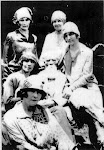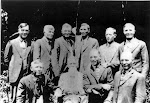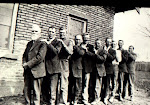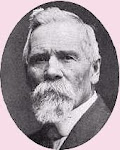I found these stories about Alonzo at http://pages.suddenlink.net/nielsen/AlonzoFarnsworth.htm
Apples and the Prophet Joseph Smith
As related by Zereta Farnsworth Angle, Granddaughter
As related by Zereta Farnsworth Angle, Granddaughter
When my Grandfather, Alonzo Lafayette Farnsworth, was a very small boy, he lived in the beautiful city of Nauvoo with his parents, brothers, sister and the other good and faithful Latter-day Saints.
On a beautiful day in late summer, my Grandfather was playing near his home with some larger boys. Just over the fence were some trees, loaded with large, red, juicy apples, which belonged to the Prophet Joseph Smith.
One of the boys suggested that they get some apples to eat as they had been playing hard and were very hungry. No sooner said than done. They all scrambled through the fence and stood under the tree, but the apples were far above their heads. After studying awhile, they put my Grandfather up in the tree to throw the apples down to them. While they were thus engaged, they saw the prophet coming towards them. The older boys became so frightened that they ran away without helping Grandfather out of the tree.
The Prophet gently lifted Grandfather from the tree and asked him if he hadn't been told by his parents that it was wrong to take things that belonged to someone else. Grandfather answered that yes, he had been taught that and many other things. The Prophet told Grandfather that if he would come and ask for what he wanted, the Prophet would gladly share with him. The Prophet then filled his arms with apples and sent Grandfather to tell the other boys to please ask the next time before helping themselves.
My Grandfather was an old white-haired man when he told me this story, but he still remembered through all the years how kind and noble the Prophet was. Grandfather left me his testimony that he knew beyond a doubt that Joseph Smith was a true Prophet of the living God.
History of Alonzo LaFayette Farnsworth
Pioneer of 1852 -- Higby Company
Pioneer of 1852 -- Higby Company
Alonzo LaFayette Farnsworth, son of Stephen Martindale Farnsworth and Julia Ann Clark, was born October 22, 1841, in South Bend, Indiana . He came to Utah in 1852 with the Higby Company of which his Father was captain. [See LDS Church On-line Archives for additional information. Although noone in the Farnsworth family kept a journal of this journey, others in the company did. Some of these journals are available on the website.] They settled in Pleasant Grove, Utah .
Alonzo married Mary Ann Staker in the Endowment House in Salt Lake City on September 8, 1866. Mary Ann was a beautiful woman who taught school in the early days of Utah and wrote beautiful poetry. To her dismay, she didn't have any children, which in those days was a real tragedy.
After ten years of marriage and no children, Alonzo was advised by Brigham Young to consider plural marriage. In 1874 he married Christanna Bertelson of Mount Pleasant, and one year later he married Ida Tietjen, from Santa Quinn, Utah. In the next twenty years they had seventeen children, twelve sons and five daughters, of which they were very proud.
Alonzo was a Lieutenant in the Black Hawk Indian War. After the war he was called to settle Richfield, Utah and was a member of the High Council there about 1871. Later he was called to settle Joseph City and live the United Order. He was also the Bishop of Joseph City while he lived there.
Dancing was one of the recreational activities enjoyed in Joseph City. Sometimes, especially on holidays, two dances would be going on at once, one in the school house, and the overflow crowd dancing in the big room of the Alonzo Farnsworth adobe home across the street.
In 1877 Alonzo was called into President Brigham Young's office. President Young said, "Lon, I want someone to go to Arizona ( Tuba City ) to make peace with the Indians there. Do you want to go?" Alonzo replied, "I'll go where I'm told to go." President Young, in a loud voice said, "Do you want to go?" Father, in a louder voice replied, "I'll go where I'm told to go." President Young said, "You're the man I want to go to Arizona and make friends with the Indians. I promise you and your family will not lose by your going there. I also promise you and your family health and strength." The family went and did indeed make friends with the Indians. They took care of sick Indians in their home and gained the love and confidence of the Indian people. Not one of the family died from sickness or disease. One child was lost through an accident and one baby did not live. The other family members lived a long life.
On one occasion, before they had time to raise a crop, they were waiting for supplies to come from Salt Lake City and they ran out of food. All they had was some corn that was so rotten they could not wash it because it would have just floated away. They cooked the corn and asked God to bless it that it would nourish and strengthen their bodies. Not one of them got sick.
Alonzo ran a general store at Tuba City . One day when he was not there, some Indians came into the store. The clerk saw one of them stealing wool and shot at him, thinking to frighten them. Instead, he hit the Indian in the hand, which made he and the others very mad. The Indians said they would get their friends, come back later that night and kill everyone in town. The whole town was scared stiff as there was no one close enough to help them and there were thousands of Indians. The town people waited in their homes all night long for the Indians to come, but they didn't show tip that night or the next night. The following day Alonzo was riding just outside of town when an Indian rode up beside him and handed him a beautiful blanket and said, "I don't want this," which was his way of saying, "I want you to have this." The Indian told Alonzo that a council of war had been held and many Indians wanted to kill the town people. But, because Alonzo and his families had been very kind to the Indians and had so many friends among them, the Indian Chief was persuaded not to attack the village. Alonzo and his families lived in Tuba City until the government bought all the land and made it into an Indian Reservation. At that point in time government officials were bothering the saints because of polygamy and so Alonzo took his families and went to Mexico .
Alonzo was a carpenter and saw mill man. He could build the nicest double fireplaces. One side was in the living room, which was also the parent's bedroom. The other side of the fireplace was the children's bedroom. The family made big fires with logs, which were plentiful, and parched corn. This corn was served with thinly sliced dried venison and ground cherries, which grew all over the valley. There was a large kitchen with a big majestic range in it. All the wives had this same type of home a bock or two apart.
In 1910 they went to Salt Lake City for June Conference and to visit all the relatives in Utah and Idaho. They liked the country and decided to move to Moreland, Idaho, where they lived until 1920. They then decided to go back to Mexico to spend their remaining years with their boys, some of whom had stayed there. Alonzo passed away in his sleep at the age of ninety years, in Colonia Garcia, Chihuahua, Mexico in the year 1931.
"History is based on information from Jennie Farnsworth Robbins. "Additional Resource: "Dancing, A Pioneer Tradition," Treasures of Pioneer History, Kate B. Carter.
Alonzo Lafayette Farnsworth
• Born: South Bend, Indiana on October 22, 1841
• Married to Mary Ann Staker in the Endowment House in Salt Lake City on September 8, 1866
• Married Christanna Bertelson on 9 March 1874.
• Married Ida Henrietta Tietjen on 5 April 1875.
• Died: 16 May 1931 in Colonia Garcia, Chihuahua, Mexico.



